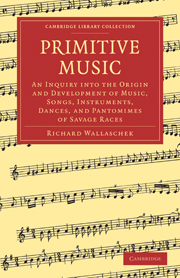
-
Select format
-
- Publisher:
- Cambridge University Press
- Publication date:
- August 2010
- July 2009
- ISBN:
- 9780511693731
- 9781108003728
- Dimensions:
- Weight & Pages:
- Dimensions:
- (216 x 140 mm)
- Weight & Pages:
- 0.45kg, 352 Pages
- Subjects:
- Music, Music: General Interest, Music Criticism
You may already have access via personal or institutional login- Subjects:
- Music, Music: General Interest, Music Criticism
Book description
This 1893 study of the music, instruments and dance of the world's indigenous peoples reflects the Victorian view that human development moved from primitive to complex along a linear evolutionary path. Despite this standpoint, it was an important contribution to comparative musicology in the late nineteenth century, demonstrating the principle that studying the music of non-European cultures and societies could help Europeans understand their own musical tradition. On the basis of his comparative analysis, Wallaschek developed a theory that music originated from rhythm and dance rather than the melody of speech. His proposed model moved forward that of Wagner, and recognised that music is embedded as a fundamental element of social interaction. The book describes music and instruments around the world, the role of singing and dance, and tonality and harmony, before discussing the origin of music and the role of heredity and external circumstances on musicality.
Contents
Metrics
Full text views
Full text views help Loading metrics...
Loading metrics...
* Views captured on Cambridge Core between #date#. This data will be updated every 24 hours.
Usage data cannot currently be displayed.
Accessibility standard: Unknown
Why this information is here
This section outlines the accessibility features of this content - including support for screen readers, full keyboard navigation and high-contrast display options. This may not be relevant for you.
Accessibility Information
Accessibility compliance for the PDF of this book is currently unknown and may be updated in the future.


